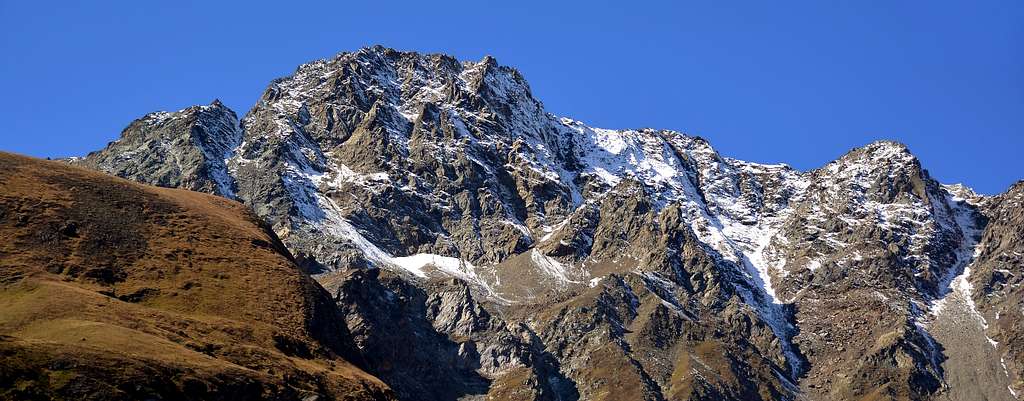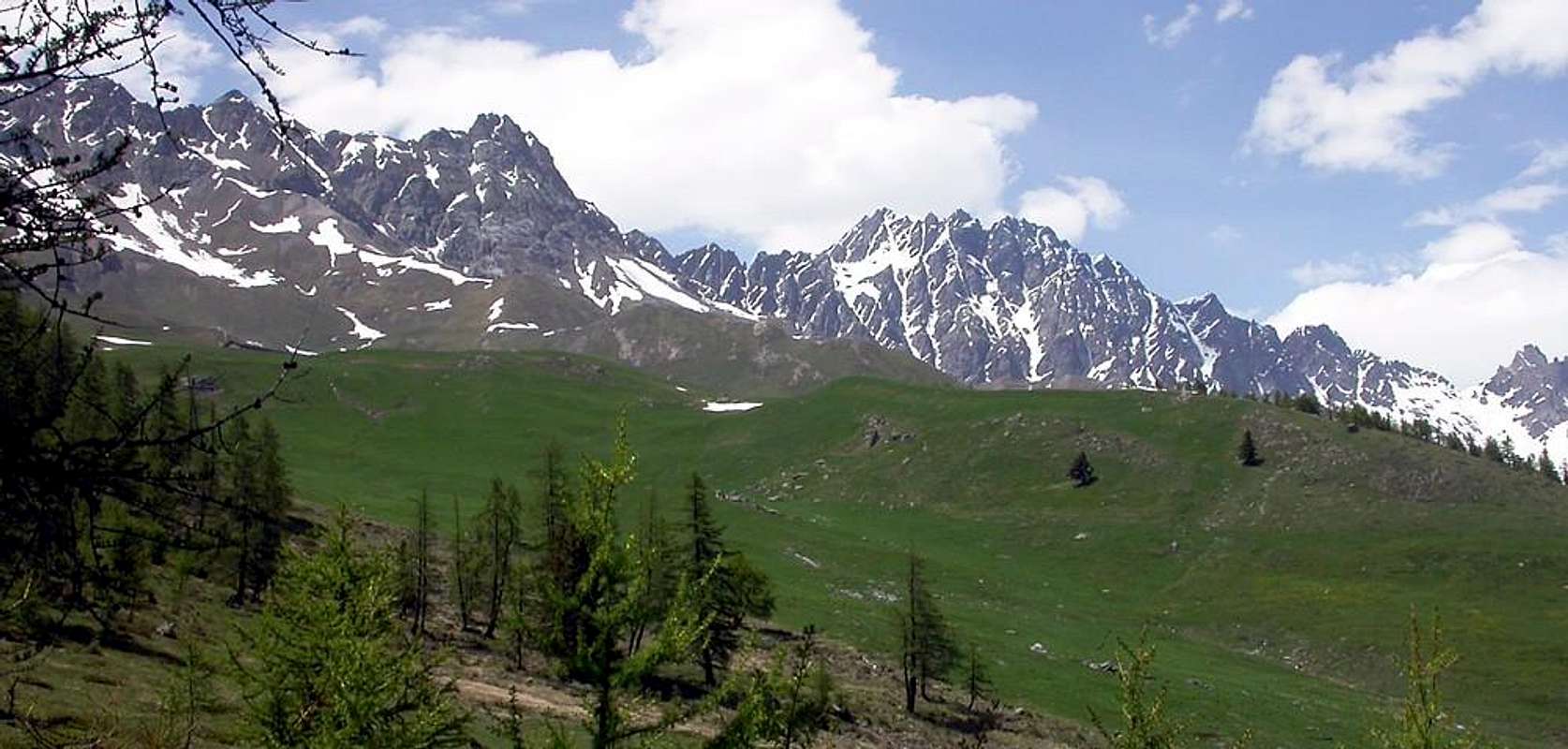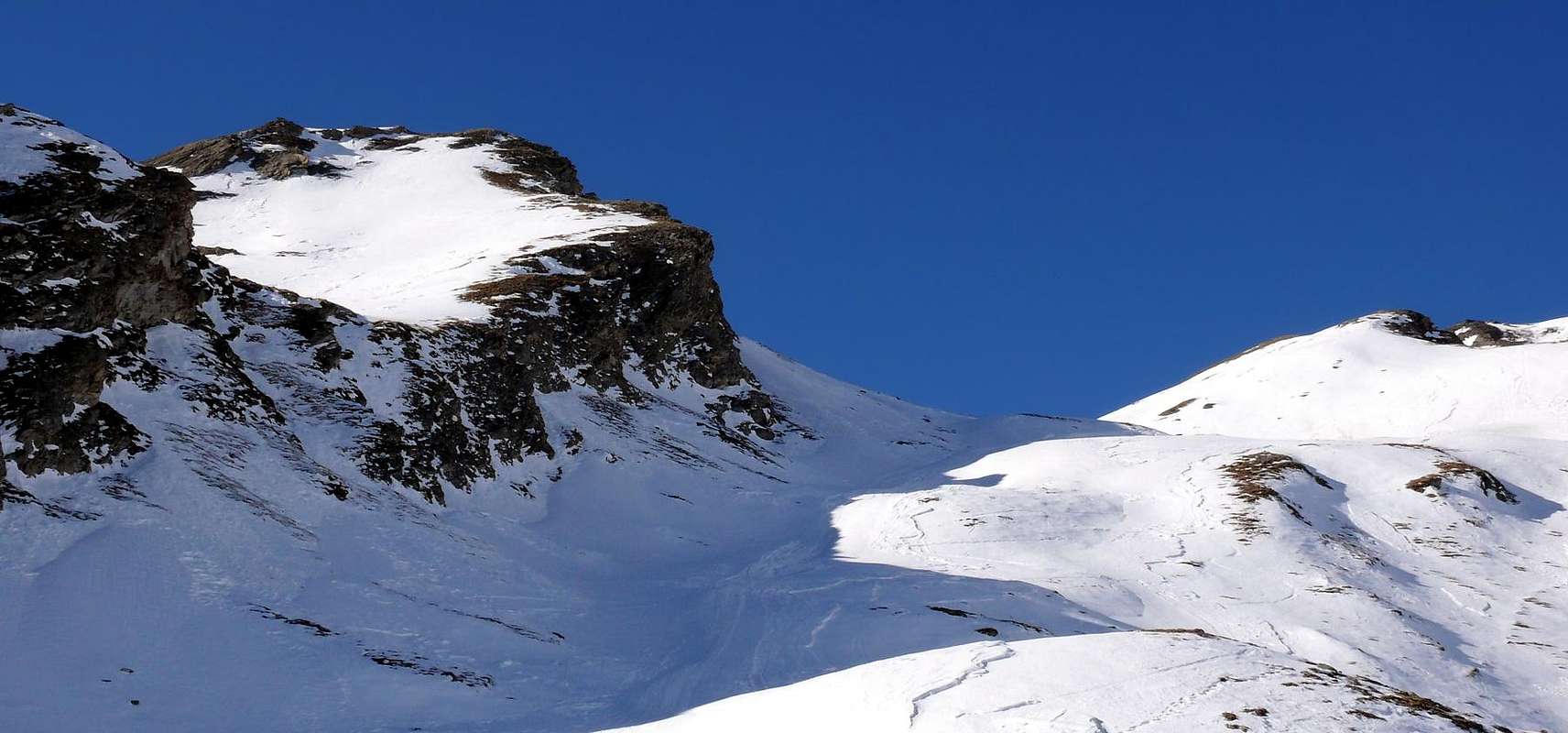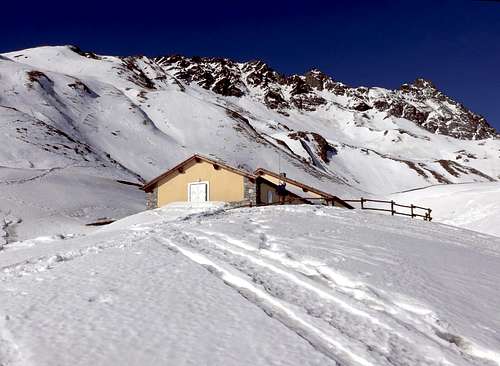-
 6308 Hits
6308 Hits
-
 87.31% Score
87.31% Score
-
 24 Votes
24 Votes
|
|
Mountain/Rock |
|---|---|
|
|
45.87089°N / 7.25510°E |
|
|
Mountaineering |
|
|
10919 ft / 3328 m |
|
|
Overview

Fine pyramidal shaped mountain, sited half way between Mont Velan and Mont Saron, overlooking the built area of Allain and well visible from Aosta. From its summit a wide view on the close Mont Vélan, on the Gelé-Morion Ridge and on Gran Combin Massif. Seen from the South it appears as a regular as well as isolated pyramid, in which the upper part is constituted by the South Wall, vertical for 110 meters and inaccessible; the same is contained by two edges of which the one on the right or S-SE has already been traveled both uphill and downhill, while the opposite or SW, equally steep but higher and (about 430 meters), is still "virgin". Both in the East and in the West it appears instead as a "squat" and squared mountain with a perfectly rectangular shape: on the East side, above the Conca di Berruard, a wall of broken rocks falls, limited to the left (South) by a clear and long (500m~) rib , which leads to the Southern Summit while further to the North another similar rises in parallel which reaches the Northern Summit (3.218m). On the opposite or Western side, above the Valloni di Menouve and Molline (Etroubles) rises a SW "Crestone" of over 700 meters and which, starting just above Alpe Arvus (1.983m), leads to the Northern Summit of a little less high and (3.218m). To be precise, the same does not directly reach the latter, but the I ° of the three Heads of Faudery, located immediately North of it, even if a few meters away. On this Western side there are three other routes:

First Ascent
- First on the Summit: Alfred Georges Topham, Jean Maitre and Pierre Maurys, (Jul 07th, 1898).
- First ascent in winter Osvaldo Cardellina, solo, (Dec 27th, 1983); in ascent from Glacier Hamlet, Berruard, Les Seitives, Chesal, Vieille, Les Econdu Pastures and crossing Faudery Torrent with crossing on three Tête di Faudery (Southern or I° 3310 meters, the highest, Central or II° 2.999 meters, Northern or III° 3.264 meters), round trip on summit crest route; in descent towards Salliaousa's Col, Tête des Crêtes, Mont Chenaille, Col Champillon and Alp, Plan Debat.
- W Wall (to Southern Top): Osvaldo Cardellina and Danilo Garzotto, (Sep 25th, 1994), in ascent from Prailles Dessous Hamlet, fork 1614 meters on Menovy Torrent near Quaye, Menovy Alp, L'Arvus Pastures to Southern Top; in descent from Northern Summit through the Western Couloir of the same face.
- W Couloir (from summit crest): Osvaldo Cardellina and Danilo Garzotto, (Sep 25th, 1994), in descent to Molline/Menouve Vallons, after ascent on West Face.
- SW Ridge (from Menouve/Molline Vallons towards Faceballa's Saddle): Osvaldo Cardellina and Alessandro Cardellina, (Aug 30th, 2005); in ascent from Prailles, Menovy, Arvus Pastures with traverse to three Teste di Faudery and four Punte di Faceballa, Faceballa Col and Saddle; in descent to Molline Bivouac.
- S-E Slope (from Colle of Salliaousa): Abbé Pantaleon Bovet and Abbé Joseph Henry, (Aug 03th, 1904).
- S-SE Edge (Salliaousa Col): Osvaldo Cardellina, (Jun 17th, 1976); in ascent after traverse Col Champillon, Mont Chenaille, Tête des Crêtes, Col de la Salliaousa.
- S-SE Edge (Salliaousa Col): Osvaldo Cardellina and Danilo Garzotto, (Oct 15th, 1996), in descent towards Col de la Salliaousa with crossing to Champillon Hill.
- E Wall (Southern Rib or left route): Osvaldo Cardellina, lone, (Oct 29th, 1988); in ascent from Glacier Hamlet, Berruard, Les Seitives, Chesal, Pleytau, Praz du Champ, Econdu Pastures and crossing Faudery Torrent; in descent towards Ansermin, Crêtes Alps, Voex and Rey Hamlets and Ollomont Village.
- E Wall (Northern Rib or route on right side with traverse on three Teste di Faudery, round trip): Osvaldo Cardellina, solo, (Dec 27th, 1983); in ascent from Glacier, Berruard, Les Seitives, Chesal, Vieille, Econdu; in descent towards Salliaousa Col, Tête des Crêtes, Mont Chenaille, Col Champillon and Alp, Plan Debat.
Getting There
BY CAR:- From Torino, Milano, etc: Motorway A5. Exit Aosta Est.
- From Switzerland: through the Grand St. Bernard Tunnel or the homonym pass.
- From France: through Mont Blanc Tunnel or Petit St. Bernard Pass. It isn't necessary to enter in Motorway A5, you can drive through SS.26 Aosta direction.
- Aeroporto "Corrado Gex" Saint Christophe (Aosta).

Itinerary
From Aosta (583m) along the SS.27 of Gran San Bernardo for about 10km, at a fork turn to the left toward Allein and, after passing Doues, on until the Champillon (2.078m) foreground where the route starts.Route
From Champillon (2.078m) follow marks to Rifugio Champillon (2430m) and Colle di Champillon (2.709m) using a well marked path along the combe. Follow to NW and after passing a grassy-debris rise, on tracks, you get the conterfort (2.991m), cross the S and N Summits of Mont Chenaille (3.144m), down on blocks along the N ridge and, after a slab, on along the S ridge up to the Tête des Crêtes (3.212m). Along the ridge cross two more summits to get, slightly descending, the narrow notch named Colle della Salliaousa (3.203m). Cross to the right using a ledge and, after a short channel, up to the S Summit (3.309m). The following ridge, almost 300 meters long, leads to the main summit (3.328m) 4h'00/5h'00.Difficulty
This route can be considered F+/PD-.Gear
Hiking gear (spare rope).Huts
Campings
Remember that free camping is forbidden (except for emergency reasons, over 2.500m, from darkness until dawn).Mountain Conditions
- Meteo: you can find all the needed informations at the official site of the Valle d'Aosta Region:
- Valle d'Aosta Meteo
Webcam
- WEBCAM on Aosta Valley:
- Webcam
Books and Maps
BOOKS:- "Guida delle Alpi Occidentali", di Giovanni Bobba e Luigi Vaccarone C.A.I. Sezione di Torino Volume II (parte II), 25 Maggio 1896.
- "Guida dei Monti d'Italia-Alpi Pennine" (Vol. I°) di Gino Buscaini-Club Alpino Italiano/Turing Club Italiano, Luglio 1971 (in Italian).
- "Diari Alpinistici" di Osvaldo Cardellina e Indice Generale accompagnato da Schedario Relazioni Ascensioni 1964-2019 (unpublished).
- "80 itinerari di Escursionismo Alpinismo e Sci Alpinismo in Valle d'Aosta", di Osvaldo Cardellina, Ed. Musumeci, Giugno 1977 (in Italian); seconda Ed. Luglio 1981; terza Ed. Luglio 1984; (in French), prima Ed. Febbraio 1978; seconda Ed. Marzo 1980.
- "Guida della Valpelline" de l'Abbè Joseph-Marie Henry-Societè Editrice Valdotaine 1925 II Edition e Collana Reprint Musumeci (1986).
- Kompass "Monte Bianco Valle d'Aosta Sentieri e Rifugi" Carta turistica 1:50.000.
- L'Escursionista "Gran San Bernardo Ollomont" Ed. Rimini (carta n° 3) 1: 25.000.
- I.G.C. Istituto Geografico Centrale "Carta dei sentieri e dei rifugi" 1:25.000.
- I.G.C. Istituto Geografico Centrale "La Valpelline Ollomont, Saint Barthélemy", (carta n° 115) Map1:30.000.
- L'Escursionista "Gran San Bernardo Ollomont" Ed. Rimini (n° 5) 1: 25.000.
Important Information
- REGIONE AUTONOMA VALLE D'AOSTA the official site.
- FONDAZIONE MONTAGNA SICURA Villa Cameron, località Villard de la Palud n° 1 Courmayeur (AO) Tel: 39 0165 897602 - Fax: 39 0165 897647.
- SOCIETA' DELLE GUIDE DELLA VALPELLINE Etroubles-Strada Nazionale, n° 13 - Tel +39 0165 78559 - Valpelline-Loc Capoluogo, n° 1 - Tel +39 0165 713502 (AO) Italia.
- A.I.NE.VA. (Associazione Interregionale Neve e Valanghe).
Useful numbers
- Protezione Civile Valdostana località Aeroporto n° 7/A Saint Christophe (Ao) Tel. 0165-238222.
- Bollettino Meteo (weather info) Tel. 0165-44113.
- Unità Operativa di Soccorso Sanitario Tel. 118.





